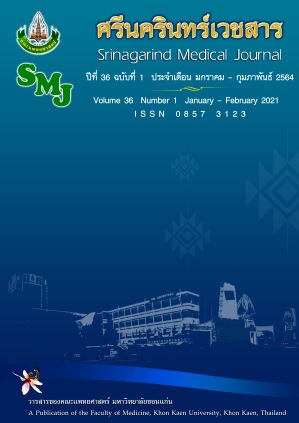Radiation Doses at Eye Lens and Thyroid Gland of Patients and Medical Staffs Received from Video Fluoroscopy
Abstract
ปริมาณรังสีที่เลนส์ตาและต่อมไทรอยด์ที่ผู้ป่วยและผู้ปฏิบัติงานได้รับจากการตรวจวิดีโอฟลูออโรสโคปี
สมศักดิ์ วงษ์ศานนท์1, เพชรากร หาญพานิชย์1, ภัทรา วัฒนพันธุ์2, อรุณนิตย์ บุญรอด1,
กันตพงศ์ ใจวงษ์3, ปนัสดา อวิคุณประเสริฐ4*, วิทิต ผึ่งกัน5
1 ภาควิชารังสีวิทยา คณะแพทยศาสตร์ มหาวิทยาลัยขอนแก่น จ.ขอนแก่น
2 ภาควิชาเวชศาสตร์ฟื้นฟู คณะแพทยศาสตร์ มหาวิทยาลัยขอนแก่น จ.ขอนแก่น
3 สาขาวิชาฟิสิกส์ คณะวิทยาศาสตร์ มหาวิทยาลัยขอนแก่น จ.ขอนแก่น
4 ภาควิชารังสีวิทยา คณะแพทยศาสตร์วชิรพยาบาล มหาวิทยาลัยนวมินทราธิราช กรุงเทพฯ
5 กลุ่มมาตรฐานการวัดทางนิวเคลียร์และรังสี สำนักงานปรมาณูเพื่อสันติ กรุงเทพฯ
บทคัดย่อ
หลักการและวัตถุประสงค์: ตรวจวัดปริมาณรังสีที่เลนส์ตาและไทรอยด์ที่ผู้ป่วยและผู้ปฏิบัติงานได้รับจากการตรวจวิดีโอฟลูออโรสโคปี การสำรวจปริมาณภายในและภายนอกห้องตรวจ และเปรียบเทียบปริมาณรังสีที่เลนส์ตาและไทรอยด์ได้รับเมื่อใช้เทคนิคฟลูออโรสโคปีที่แตกต่างกันในหุ่นจำลองศีรษะ
วิธีการศึกษา: ใช้อุปกรณ์วัดปริมาณโอเอสแอล ติดที่เลนส์ตาและไทรอยด์ในผู้ป่วยและผู้ปฏิบัติงาน และหุ่นจำลองศีรษะ เพื่อวัดค่าปริมาณรังสี และใช้อุปกรณ์วัดปริมาณรังสีโอเอสแอลเพื่อสำรวจปริมาณรังสีภายในและภายนอกห้องตรวจฟลูออโรสโคปี
ผลการศึกษา: ผู้ป่วยได้รับปริมาณรังสีเฉลี่ยสูงสุดที่ไทรอยด์ด้านขวา 645.4 µSv/min ผู้ปฏิบัติงานได้รับปริมาณรังสีเฉลี่ยที่เลนส์ตาในช่วง 1-2.4 µSv/min ปริมาณรังสีภายในและภายนอกห้องฟลูออโรสโคปี มีค่าอยู่ในเกณฑ์ปลอดภัย การเลือกใช้เทคนิคฟลูออโรสโคปีที่ต่างกัน ส่งผลต่อความละเอียดและสัญญาณรบกวนของภาพ และปริมาณรังสีจากเทคนิคการปล่อยรังสีต่อเนื่องมีค่าสูงกว่าการใช้เทคนิคการปล่อยรังสีแบบเป็นจังหวะ
สรุป: การป้องกันอันตรายจากรังสี สามารถทำได้โดยการปรับเปลี่ยนเทคนิคที่ใช้ในการตรวจ การเลือกใช้อุปกรณ์ในการตรวจ การอบรมทบทวนความรู้ให้กับผู้ปฏิบัติงานในด้านการป้องกันอันตรายจากรังสี รวมถึงการที่ผู้ปฏิบัติงานได้รับทราบปริมาณรังสีที่ตนเองได้รับจากการปฏิบัติงานจะช่วยเพิ่มความตระหนักถึงอันตรายจากรังสีมากขึ้น
คำสำคัญ: ปริมาณรังสีที่เลนส์ตาและต่อมไทรอยด์; ฟลูออโรสโคปี; อุปกรณ์วัดปริมาณโอเอสแอล
Background and Objective: This study aimed to measure radiation exposure to eye lens and thyroid of patients and medical staffs during x-ray fluoroscopy. The measurement of area radiation dose inside and outside of fluoroscopic room were also observed. The radiation dose to eye lens and thyroids from different fluoroscopic techniques were measured in head phantom.
Methods: Optically stimulated luminescence (OSL) dosimeters were placed on eyes and thyroid of patients and staffs, and head phantom for radiation dose measurement. The survey of area radiation dose was conducted using OSL dosimeters.
Results: Patients underwent fluoroscopy received the highest dose at right thyroid at 645.4 µSv/min. Staff’s thyroid and hands received radiation dose in the range of 1-2.4 µSv/min. The radiation doses inside and outside fluoroscopic room were in the safety level. The different fluoroscopic techniques affect the resolution and noise of images. The continuous fluoroscopic technique releases higher radiation dose than the pulse fluoroscopic technique.
Conclusions: Radiation protection considerations can be performed by adjusting the appropriate exposure techniques, using the radiation protective equipment, training and providing staff knowledge’s. Also, the monitoring of personal dose received from work will enhance an individual self’s awareness of radiation protection.
Keywords: radiation dose in eye lens and thyroid; fluoroscopy; OSL


